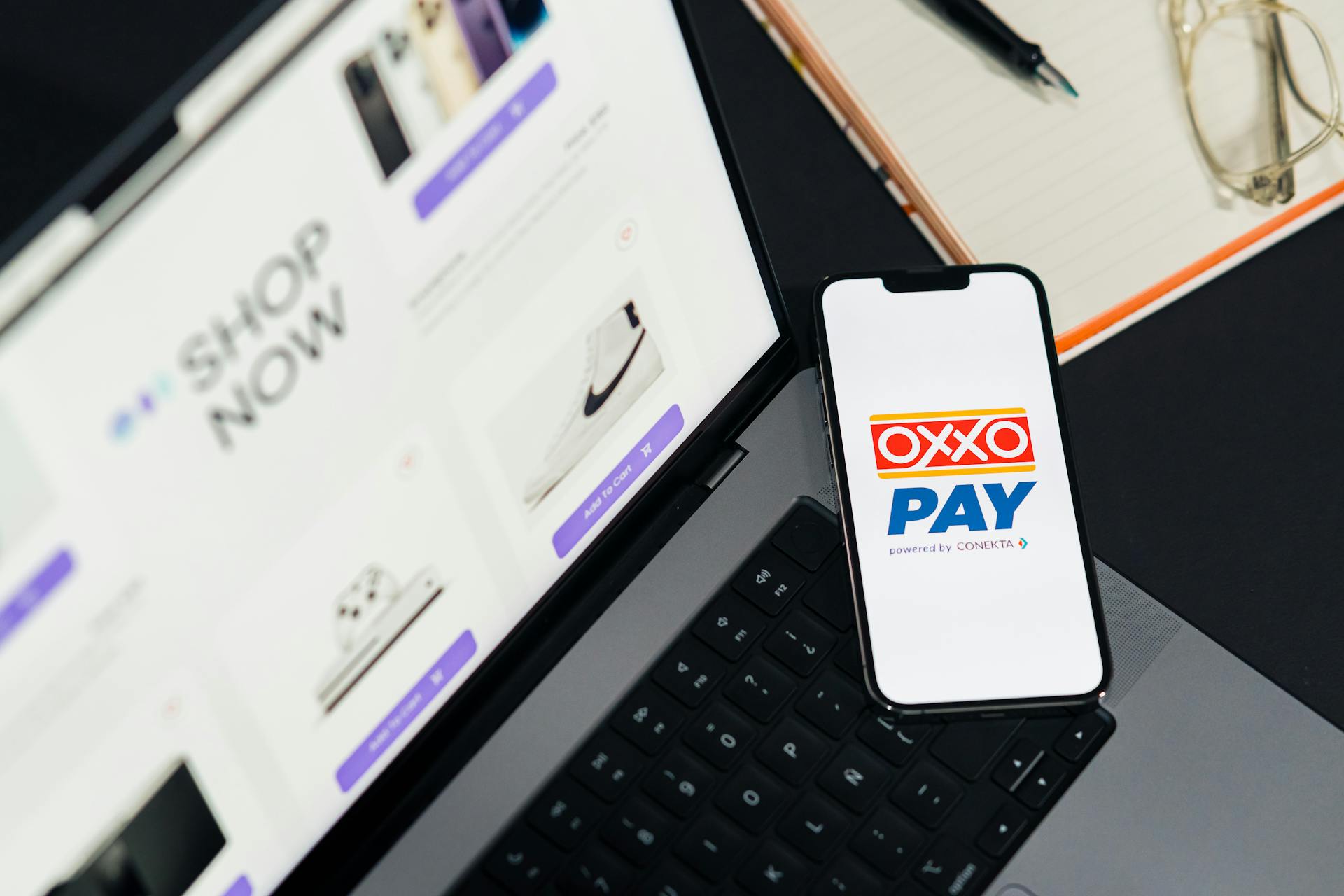
Zelle and Venmo are two of the most popular peer-to-peer payment apps out there, but they have some key differences.
Zelle is owned by major banks, including Bank of America, Capital One, and Wells Fargo, which means it's often integrated into banking apps and websites. This can make it easier to send and receive money.
One of the main benefits of Zelle is its speed - most transactions are processed in just a few minutes, making it a great option for splitting bills or sending money to friends.
For your interest: Shop Now Pay Later Apps
What is Zelle and Venmo?
Zelle is a peer-to-peer payment service that allows users to send and receive money directly from their bank accounts. It was launched in 2017 by Early Warning Services, a company owned by several major US banks.
Zelle is integrated into many banking apps, making it a convenient option for those who already use their bank's app. I've seen friends use it to split bills or send money to each other quickly and easily.
Venmo, on the other hand, is a social payment service that allows users to send and receive money, as well as share payment activity with friends. It was acquired by PayPal in 2013 and has since become a popular way to split bills or send money to friends.
Check this out: Venmo Only Accept from Friends
What is Zelle?
Zelle is a peer-to-peer payment service that allows users to send and receive money directly from one bank account to another. It's a relatively new player in the digital payment space.
Zelle was launched in 2017 by Early Warning Services, a company owned by several major US banks. It's since become one of the most popular digital payment services in the country.
To use Zelle, you'll need to have a bank account with a participating bank, as well as a smartphone with the Zelle app. Some banks also offer Zelle as a feature within their mobile banking apps.
The service is known for its speed and convenience, with funds often arriving in the recipient's account within minutes of the transaction being sent.
Expand your knowledge: Do Banks Sell Money Orders
What is Venmo?
Venmo is a peer-to-peer payment service owned by PayPal, allowing users to send and receive money in the United States. It was founded in 2009 and acquired by PayPal in 2013.
The service allows users to link their credit or debit cards, or even their bank accounts, to make payments. Venmo's mobile app lets users easily transfer funds to friends or family members.
Venmo's social aspect is a key feature, as users can share transaction details on their feed, allowing friends to see what they're buying or paying for. This can be a fun way to keep up with friends' spending habits.
Transactions on Venmo are typically free, with no fees for standard payments. However, there may be fees for instant transfers to a bank account or using a credit card.
A different take: Venmo Family and Friends
Key Features and Comparison
Zelle and Venmo are two popular payment services that offer convenient ways to send and receive money. Both services are free to use, although you'll need to check your own bank or credit union to see if they charge a fee for using Zelle.
Zelle is a gateway service that allows you to send and receive funds directly from your linked bank account or card, while Venmo has a digital wallet function that lets you hold a balance. If your bank allows Zelle payments, you can use it with your regular online banking app, but Venmo users will need a separate app to make payments.
You might enjoy: Venmo Goods and Services vs Paypal
Here are the key features of each service:
Zelle payments are typically available within minutes, while Venmo standard transfers are free but take longer, and instant transfers come with a 1.5% fee.
Money Transfer Speed
Money transfer speed is a crucial aspect to consider when choosing between Zelle and Venmo. Zelle's money transfer speed is quite impressive, with payments arriving in just a few minutes if the recipient is already registered with Zelle.
However, if the recipient doesn't have a Zelle account, they must set one up within 14 days to receive the payment, or it will be cancelled and the money returned to you.
Venmo's standard transfers take 1 to 3 business days, but you can opt for instant transfers that arrive in 30 minutes for a fee of 1.5% of the transfer amount, or $0.25 to $10, whichever is less.
Here's a comparison of the two services' transfer speeds:
In summary, Zelle's transfer speed is generally faster than Venmo's, especially for instant transfers.
Integrations

Zelle has very limited integrations, even from third-party providers, making it best for direct account-to-account transfers using a banking app.
Venmo, on the other hand, has a wider range of integrations, including online checkouts, which is a major advantage for businesses.
Most ecommerce platforms that allow PayPal integrations also have a Venmo checkout button, making it a convenient option for online transactions.
Zelle's limited integrations mean it's not ideal for online checkouts, whereas Venmo is a great choice for businesses that want to engage with customers through social payment features and online integrations.
Venmo's online checkout capabilities give it an edge over Zelle, especially for businesses that want to make it easy for customers to pay online.
A different take: Google Checkout
Security and Safety
Both Venmo and Zelle are considered highly secure platforms, with Venmo benefiting from PayPal's extensive experience in online payment security.
Venmo uses encryption to keep your details safe and monitors all transactions for suspicious activity or potential fraud.
Explore further: B of a Mobile Banking App
You can also add an extra layer of security to your Venmo account by setting up a PIN on your phone, which can be disconnected if you lose your phone or suspect it's been compromised.
Zelle, on the other hand, has bank-level security and adheres to each bank's strict security protocols, making it a secure option for sending and receiving money.
Zelle also takes steps to ensure your personal details and money are secure, including authorization before payments are made and monitoring for potential fraud.
On a similar theme: Security Issues with Venmo
Transaction Reversibility
Transaction reversibility can be a gray area with popular payment services.
Unfortunately, Zelle transactions are not reversible if both the sender and recipient are enrolled with Zelle.
Venmo payments can't be canceled as the funds are immediately available to the recipient.
Contacting Venmo's customer support might be the best option if you're looking to reverse a payment.
If the recipient doesn't have Zelle, you should be able to cancel the payment with Zelle.
For another approach, see: Carrier Billing T Mobile
Is it Safe?
Both Venmo and Zelle are considered highly secure platforms. They take the safety of their users very seriously.
Venmo benefits from PayPal's extensive experience in online payment security, which is a major plus. PayPal is one of the largest and most trusted online payment platforms globally.
Zelle has bank-level security and adheres to each bank's strict security protocols. This ensures that your personal details and money are secure.
Zelle takes steps to prevent fraud, including authorization before payments are made and monitoring for suspicious activity. This gives you peace of mind when sending or receiving money.
Venmo uses encryption to keep your details safe, which is a robust security measure. It also monitors all transactions for anything that looks suspicious or could indicate fraud.
If you lose your phone or believe it's been compromised, you can disconnect it from your Venmo account to stop anyone from abusing it. This adds an extra layer of security to your account.
Zelle's security is so good that it's bank-level, which is the highest level of security for online transactions. This means you can trust the platform with your money.
Broaden your view: Four Corners Model for Payment Security
FTC Data: Top Scam Platform
Zelle was the third most frequently mentioned payment network in consumer reports of scams in 2023, according to the Federal Trade Commission.
The FTC found that 20% of people who reported paying a scammer with a payment app or payment service named Zelle in their report.
Zelle's ranking corresponds roughly to its popularity among U.S. consumers, which was evident in the 2022 Consumer Reports survey.
In comparison, 28% of consumers mentioned PayPal, 24% mentioned Cash App, 9% mentioned Venmo, and 7% mentioned Apple Pay in their reports.
The FTC did not include Zelle payments that consumers reported as bank transfers in these statistics, which might have affected the results.
If this caught your attention, see: Personal Reports Charge on Debit Card
Fees and Payment Methods
Both Zelle and Venmo are cost-effective for standard transactions, making them attractive choices for businesses looking to save on payment processing fees. However, Zelle is a better option if the funding source is the customer's bank account and the bank does not charge any fees for Zelle transactions.
Venmo, on the other hand, allows customers to pay using their Venmo balance or by funding it with their bank account or credit card. Venmo will further edge out Zelle when it launches Tap to Pay on Android and iPhone, because it will allow Venmo Business accounts to accept contactless card payments without any additional hardware.
Here's a comparison of the fees for Zelle and Venmo:
Fees
Fees can be a major consideration when choosing a payment method. Venmo, for example, has a range of fees associated with its services.
Sending money through Venmo is free if you use a Venmo balance or debit card, but it costs 3% if you use a credit card.
Venmo also offers an instant transfer-to-bank option, but it comes with a fee of 1% (minimum $0.25 to $10 maximum).
If you're looking for a fee-free option, Zelle is a good choice. It doesn't charge any fees for standard transactions, but individual banks or credit unions may have their own policies or fees.
You might enjoy: Does Venmo Charge a Fee to Transfer Money
Here's a breakdown of the fees associated with Venmo and Zelle:
It's worth noting that while Venmo has a range of fees, Zelle is generally a more cost-effective option for standard transactions.
Payment Methods
Zelle only allows bank-to-bank transfers, but Venmo offers more flexibility with the option to pay using your Venmo balance.
Venmo Business accounts will soon be able to accept contactless card payments without any additional hardware.
You can fund your Venmo account with your bank account or credit card, giving you more payment options.
Over 2 million retailers in the U.S. are now accepting Venmo, making it a convenient choice for many users.
Venmo allows you to retain a cash balance in your account, so you don't need to withdraw funds from your checking account every time you need to pay a friend.
Frequently Asked Questions
What is the downside of using Zelle?
Zelle's main limitation is its restricted functionality, only allowing person-to-person transfers between U.S. bank accounts. This means you can't use it for international transactions or credit card payments
Why would someone use Zelle instead of Venmo?
Choose Zelle for instant, secure payments that bypass third parties, just like direct deposits from your employer or government
Why do people use Zelle instead of Venmo?
People use Zelle for its fee-free instant transfers, making it a convenient option for sending money quickly without extra charges. This feature sets Zelle apart from other payment services like Venmo.
Is Zelle the best way to send money?
Zelle is a convenient way to send money to anyone, regardless of their bank, making it easy to get paid back or split costs. It sends money directly to your bank account, making transactions seamless and hassle-free.
Sources
- https://wise.com/us/blog/zelle-vs-venmo
- https://fitsmallbusiness.com/zelle-vs-venmo/
- https://www.americanbanker.com/news/comparing-fraud-zelle-vs-venmo-vs-paypal-vs-cash-app-vs-apple
- https://www.yahoo.com/tech/comparing-paypal-venmo-zelle-cash-090000376.html
- https://zipbooks.com/blog/paypal-vs-venmo-vs-zelle/
Featured Images: pexels.com


